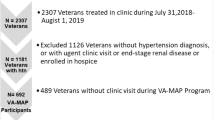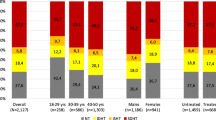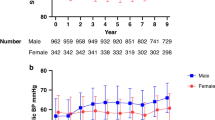Abstract
Left ventricular hypertrophy (LVH) has been associated with hypertension, although debate exists as to whether LVH is caused by elevated blood pressure (BP) or is a risk factor for its development. The present study evaluates the association between left ventricular structure and the development of hypertension in a young healthy population. We followed young healthy Israeli Air Force aviators from initial echocardiography at the start of their military service to a mean of 7.5±3.0 years. Data collection included annual BP measurements, height, weight, smoking habits, and lipid profile. We monitored 500 Air Force men with a mean age of 20.5±3.3 (range, 17−40) years and baseline BP of 125±13/74±8 mmHg. Systolic BP during follow-up was associated with baseline systolic BP, interventricular septum (IVS) thickness, and ejection fraction, whereas diastolic BP was associated only with baseline diastolic BP and body mass index. The probability that the systolic BP during follow-up would be higher than the median was twice that in those with an IVS thickness greater than the median. In conclusion, IVS thickening was associated with long-term elevation of systolic BP. Therefore, it seems that IVS thickening is not merely a result of long-term BP elevation, but may predict the development of systolic hypertension. (Hypertens Res 2008; 31: 15−20)
Similar content being viewed by others
Article PDF
References
Gardin JM, Brunner D, Schreiner PJ, et al : Demographics and correlates of five-year change in echocardiographic left ventricular mass in young black and white adult men and women: the Coronary Artery Risk Development in Young Adults (CARDIA) study. J Am Coll Cardiol 2002; 40: 529–535.
Hubert HB, Feinleib M, McNamara PM, Castelli WP : Obesity as an independent risk factor for cardiovascular disease: a 26-year follow-up of participants in the Framingham Heart Study. Circulation 1983; 67: 968–977.
Stamler J, Stamler R, Neaton JD : Blood pressure, systolic and diastolic, and cardiovascular risks. US population data. Arch Intern Med 1993; 153: 598–615.
Casale PN, Devereux RB, Milner M, et al : Value of echocardiographic measurement of left ventricular mass in predicting cardiovascular morbid events in hypertensive men. Ann Intern Med 1986; 105: 173–178.
Levy D, Garrison RJ, Savage DD, Kannel WB, Castelli WP : Prognostic implications of echocardiographically determined left ventricular mass in the Framingham Heart Study. N Engl J Med 1990; 322: 1561–1566.
Balci B, Yilmaz O, Yesildag O : The influence of ambulatory blood pressure profile on left ventricular geometry. Echocardiography 2004; 21: 7–10.
Bauwens F, Duprez D, De Buyzere M, Clement DL : Blood pressure load determines left ventricular mass in essential hypertension. Int J Cardiol 1992; 34: 335–338.
Harpaz D, Rosenthal T, Peleg E, Shamiss A : The correlation between isolated interventricular septal hypertrophy and 24-h ambulatory blood pressure monitoring in apparently healthy air crew. Blood Press Monit 2002; 7: 225–229.
Lauer MS, Anderson KM, Levy D : Influence of contemporary versus 30-year blood pressure levels on left ventricular mass and geometry: the Framingham Heart Study. J Am Coll Cardiol 1991; 18: 1287–1294.
Celentano A, Galderisi M, Garofalo M, et al : Blood pressure and cardiac morphology in young children of hypertensive subjects. J Hypertens Suppl 1988; 6: S107–S109.
de Simone G, Devereux RB, Roman MJ, Schlussel Y, Alderman MH, Laragh JH : Echocardiographic left ventricular mass and electrolyte intake predict arterial hypertension. Ann Intern Med 1991; 114: 202–209.
Mahoney LT, Schieken RM, Clarke WR, Lauer RM : Left ventricular mass and exercise responses predict future blood pressure. The Muscatine Study. Hypertension 1988; 12: 206–213.
Nishio T, Mori C, Saito M, et al : Tracking of blood pressure, height, weight and left ventricular muscle volume in children—the Shimane Heart Study. Jpn Circ J 1986; 50: 1321–1324.
Post WS, Larson MG, Levy D : Impact of left ventricular structure on the incidence of hypertension. The Framingham Heart Study. Circulation 1994; 90: 179–185.
Sahn DJ, DeMaria A, Kisslo J, Weyman A : Recommendations regarding quantitation in M-mode echocardiography: results of a survey of echocardiographic measurements. Circulation 1978; 58: 1072–1083.
Devereux RB, Reichek N : Echocardiographic determination of left ventricular mass in man. Anatomic validation of the method. Circulation 1977; 55: 613–618.
Teichholz LE, Kreulen T, Herman MV, Gorlin R : Problems in echocardiographic volume determinations: echocardiographic-angiographic correlations in the presence of absence of asynergy. Am J Cardiol 1976; 37: 7–11.
al'Absi M, Devereux RB, Rao DC, et al : Blood pressure stress reactivity and left ventricular mass in a random community sample of African-American and Caucasian men and women. Am J Cardiol 2006; 97: 240–244.
Den Hond E, Staessen JA : Relation between left ventricular mass and systolic blood pressure at baseline in the APTH and THOP trials. Blood Press Monit 2003; 8: 173–175.
Fagard R, Staessen J, Thijs L, Amery A : Relation of left ventricular mass and filling to exercise blood pressure and rest blood pressure. Am J Cardiol 1995; 75: 53–57.
Gardin JM, Wagenknecht LE, Anton-Culver H, et al : Relationship of cardiovascular risk factors to echocardiographic left ventricular mass in healthy young black and white adult men and women. The CARDIA study. Coronary Artery Risk Development in Young Adults. Circulation 1995; 92: 380–387.
Grossman E, Alster Y, Shemesh J, Nussinovitch N, Rosenthal T : Left ventricular mass in hypertension: correlation with casual, exercise and ambulatory blood pressure. J Hum Hypertens 1994; 8: 741–746.
Grossman E, Messerli FH : End-organ disease in hypertension: what have we learned? J Cardiovasc Pharmacol 1992; 20 ( Suppl 10): S1–S6.
Lorber R, Gidding SS, Daviglus ML, Colangelo LA, Liu K, Gardin JM : Influence of systolic blood pressure and body mass index on left ventricular structure in healthy African-American and white young adults: the CARDIA study. J Am Coll Cardiol 2003; 41: 955–960.
Author information
Authors and Affiliations
Corresponding author
Rights and permissions
About this article
Cite this article
Grossman, C., Grossman, A., Koren-Morag, N. et al. Interventricular Septum Thickness Predicts Future Systolic Hypertension in Young Healthy Pilots. Hypertens Res 31, 15–20 (2008). https://doi.org/10.1291/hypres.31.15
Received:
Accepted:
Issue date:
DOI: https://doi.org/10.1291/hypres.31.15
Keywords
This article is cited by
-
HIV status and survival of patients with pulmonary hypertension due to left heart disease: the Pan African Pulmonary Hypertension Cohort
Scientific Reports (2023)
-
Lifestyle intervention in obese pregnancy and cardiac remodelling in 3-year olds: children of the UPBEAT RCT
International Journal of Obesity (2022)
-
Left Ventricular Geometrical Changes in Severely Obese Adolescents: Prevalence, Determinants, and Clinical Implications
Pediatric Cardiology (2021)
-
Identification of differential gene expression profile from peripheral blood cells of military pilots with hypertension by RNA sequencing analysis
BMC Medical Genomics (2018)
-
Risks and predictors of mild diastolic dysfunction among middle-aged and aged women: a population-based cohort study
Journal of Human Hypertension (2016)



